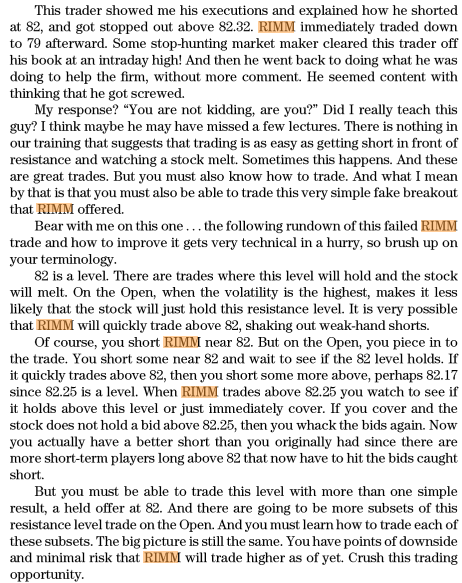In One Good Trade I offered this example of a RIMM trade:
Today I got this email from SMBer Terry:
Hello Mr. Bellafiore,
I just have a quick question about adding size to a short in a weak stock that is working against you. In your book, you reference a play in RIMM around the level of 82. The play is to get short at this level, as shared by Steve.
So you piece into this trade, since it is early in the open, and slowly add size, even if it moves against you, until it hits another level (82.25 in this case). Then you wait and hit it if it keeps rising. This strategy to me resembles doubling down a bit, and I was curious if there were better ways to do this, especially if the 2 levels you are trading off of have a substantially larger gap? Do you add size proportionally slower in a normalized fashion? Is there a general rule of thumb for adding size (arithmetic, geometric, etc.)?
Thanks again!
So was I doubling down? Is there a better way that you would trade this set up?
Mike Bellafiore
Author, One Good Trade


4 Comments on “Traders Ask- Doubling Down Bella?”
Technically yes, this is “doubling down”. Or you can call it “scaling in” or whatever. But how you call it is not really the point. The point is it’s only bad if it’s not part of your plan and if you’re reacting only to avoid a loss.
If you plan to scale into the trade gradually at some pre-determined point while always controlling your risk and having an appropriate position sizing, then it’s a great setup that can bring a lot of good trades.
This is a difficult technique to master (I am still learning it myself :p) and it takes good discipline and an actual plan before trading it. But it’s much more subtle and nuanced than a simple “all-in” trade and it allows the trader more flexibility, in my opinion.
I tried to work this into my strategy today trading SPY into the close. It actually worked pretty well right before the resistance at 133. I started shorting around 132.85. The plan was to short until it broke 133.10, though it never got that high. Did this a few times was able to follow it down to 132.75 each time. Not a huge chop but an opportunity I would normally have missed. Thanks!
Same thing with AAPL yesterday into the 351 level. Scaling in was the best play to do as logn as it was part of the plan – know the levels!
This question has many implicit components:
1. Is adding to losers good or bad?
2. Is there a right way to add to my losers and how should I add to my losers?
1. Is adding to losers good or bad?
A.
Adding to losers can work if one is skilled. What makes adding to losers bad is that it increases the size of the losses and big losses are more difficult to take. Instead of asking is this good or bad or right or wrong, one should focus on the size of the max loss and never veer from it.
2. How should I add to losers?
A.
Typically, I do not add to losers. When you first enter short you are stating, I believe this is a good price to short. You are very clearly stating that I can’t wait to put this short on. Trading short side is nothing like trading the long side because short trades often drop without much time to work a good entry. You have 2 options: use a limit order at a higher level or use a market order now. If you use a limit order then you are stating 2 things: 1. I’m not very eager to put this short on. If the market drops without me then I don’t really care. and #2 I believe the market will rally to this point. There is an opportunity cost associated with getting a better entry. If you are adding to your trade as it goes against you then either A. that was in your plan or B. you didn’t fully understand the move.
Imagine this, imagine you have a stop and you don’t want to lose any more then that amount. Now, imagine you can go long or short without any trading cost. What might you do? If you were long you might sell at your stop and buy any time the market crosses your stop. This is what spreads allow one to do.
I mention this because likely prop traders get cheaper pricing so they can trade in ways that are unlikely to work for retail traders due to the higher commissions.
Back to the original question, what does it say when someone shorts as the market moves against them? It says either A. they are very confident that the market is wrong priced or B. they were unsure where to enter and thus wanted to get a mix of the immediateness of a market order with the better pricing and opportunity cost of using a limit order. Of course, what would they do if the market moved in their favor? I suggest one will typically do better by adding to winners… although either type of adding is compounding risk. Adding to a winning trend trade is basically shorting volatility.. and so exposes one to volatility shock.